Economics Assignment: Risks of Slow Wage Growth in Australia
VerifiedAdded on 2021/05/31
|12
|2241
|15
Essay
AI Summary
This economics assignment delves into the issue of slow wage growth in Australia, examining its historical trends and underlying causes, such as shifts in employment, immigrant labor, and the decline of economic booms. The essay analyzes the potential risks associated with this trend, including its impact on aggregate demand and supply, inflation dynamics, and the labor market, potentially leading to increased unemployment and underemployment. The analysis employs economic theories to illustrate the adverse consequences of prolonged slow wage growth on the Australian economy, emphasizing the need for government monitoring and regulation to mitigate the negative impacts on both workers' welfare and overall economic well-being. The paper concludes by highlighting the long-term risks of economic stagnation if the slow wage growth persists.
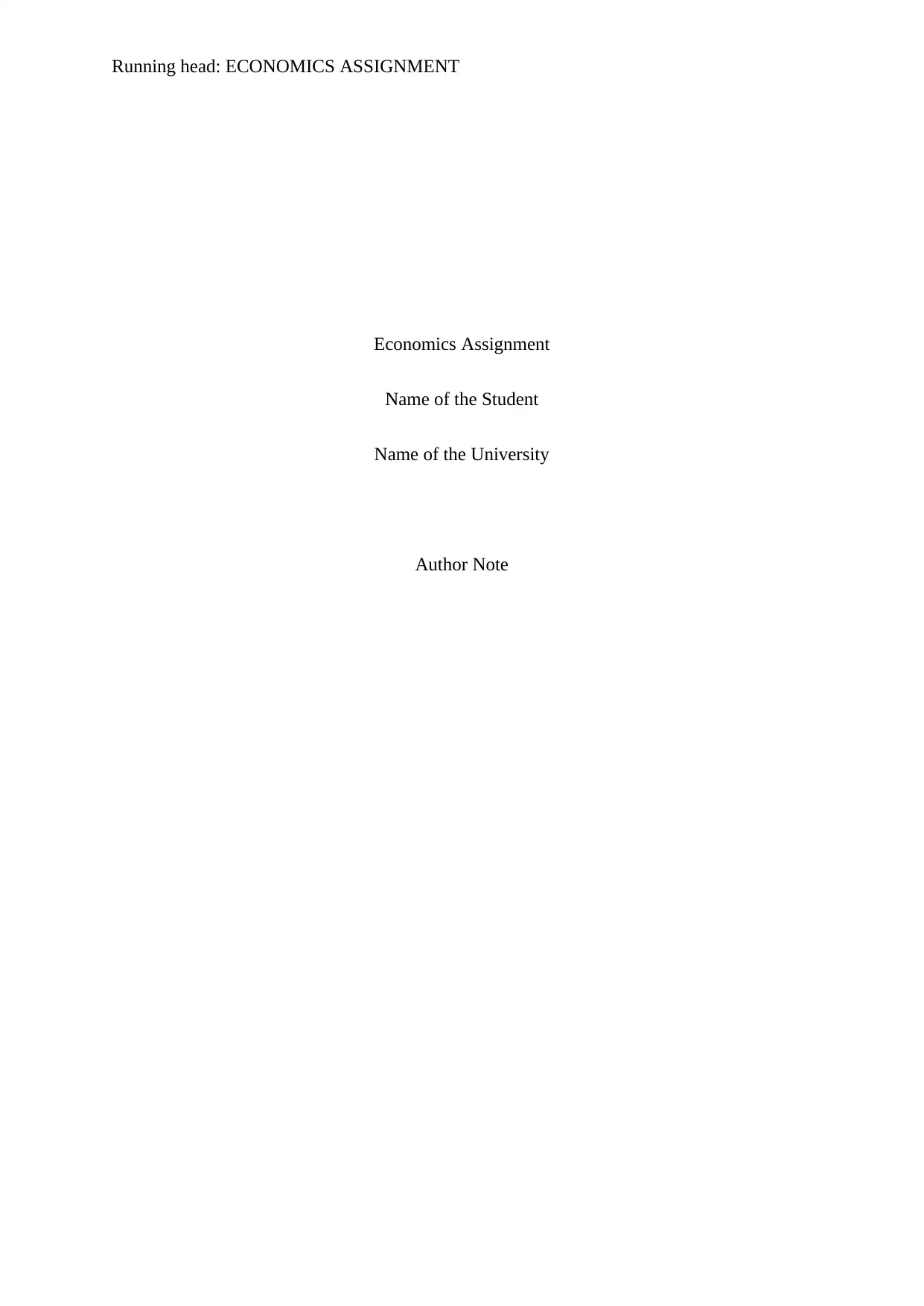
Running head: ECONOMICS ASSIGNMENT
Economics Assignment
Name of the Student
Name of the University
Author Note
Economics Assignment
Name of the Student
Name of the University
Author Note
Paraphrase This Document
Need a fresh take? Get an instant paraphrase of this document with our AI Paraphraser
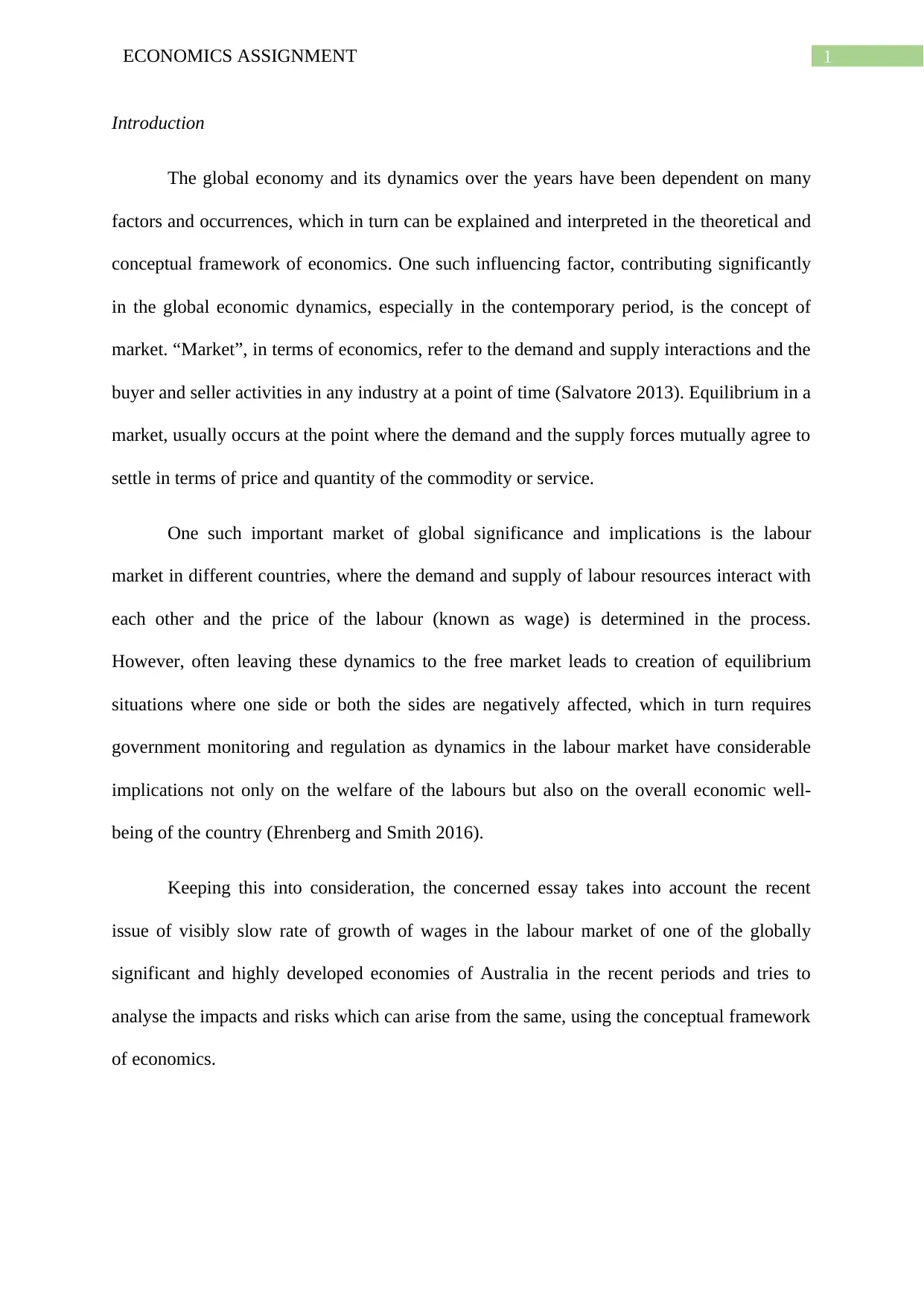
1ECONOMICS ASSIGNMENT
Introduction
The global economy and its dynamics over the years have been dependent on many
factors and occurrences, which in turn can be explained and interpreted in the theoretical and
conceptual framework of economics. One such influencing factor, contributing significantly
in the global economic dynamics, especially in the contemporary period, is the concept of
market. “Market”, in terms of economics, refer to the demand and supply interactions and the
buyer and seller activities in any industry at a point of time (Salvatore 2013). Equilibrium in a
market, usually occurs at the point where the demand and the supply forces mutually agree to
settle in terms of price and quantity of the commodity or service.
One such important market of global significance and implications is the labour
market in different countries, where the demand and supply of labour resources interact with
each other and the price of the labour (known as wage) is determined in the process.
However, often leaving these dynamics to the free market leads to creation of equilibrium
situations where one side or both the sides are negatively affected, which in turn requires
government monitoring and regulation as dynamics in the labour market have considerable
implications not only on the welfare of the labours but also on the overall economic well-
being of the country (Ehrenberg and Smith 2016).
Keeping this into consideration, the concerned essay takes into account the recent
issue of visibly slow rate of growth of wages in the labour market of one of the globally
significant and highly developed economies of Australia in the recent periods and tries to
analyse the impacts and risks which can arise from the same, using the conceptual framework
of economics.
Introduction
The global economy and its dynamics over the years have been dependent on many
factors and occurrences, which in turn can be explained and interpreted in the theoretical and
conceptual framework of economics. One such influencing factor, contributing significantly
in the global economic dynamics, especially in the contemporary period, is the concept of
market. “Market”, in terms of economics, refer to the demand and supply interactions and the
buyer and seller activities in any industry at a point of time (Salvatore 2013). Equilibrium in a
market, usually occurs at the point where the demand and the supply forces mutually agree to
settle in terms of price and quantity of the commodity or service.
One such important market of global significance and implications is the labour
market in different countries, where the demand and supply of labour resources interact with
each other and the price of the labour (known as wage) is determined in the process.
However, often leaving these dynamics to the free market leads to creation of equilibrium
situations where one side or both the sides are negatively affected, which in turn requires
government monitoring and regulation as dynamics in the labour market have considerable
implications not only on the welfare of the labours but also on the overall economic well-
being of the country (Ehrenberg and Smith 2016).
Keeping this into consideration, the concerned essay takes into account the recent
issue of visibly slow rate of growth of wages in the labour market of one of the globally
significant and highly developed economies of Australia in the recent periods and tries to
analyse the impacts and risks which can arise from the same, using the conceptual framework
of economics.
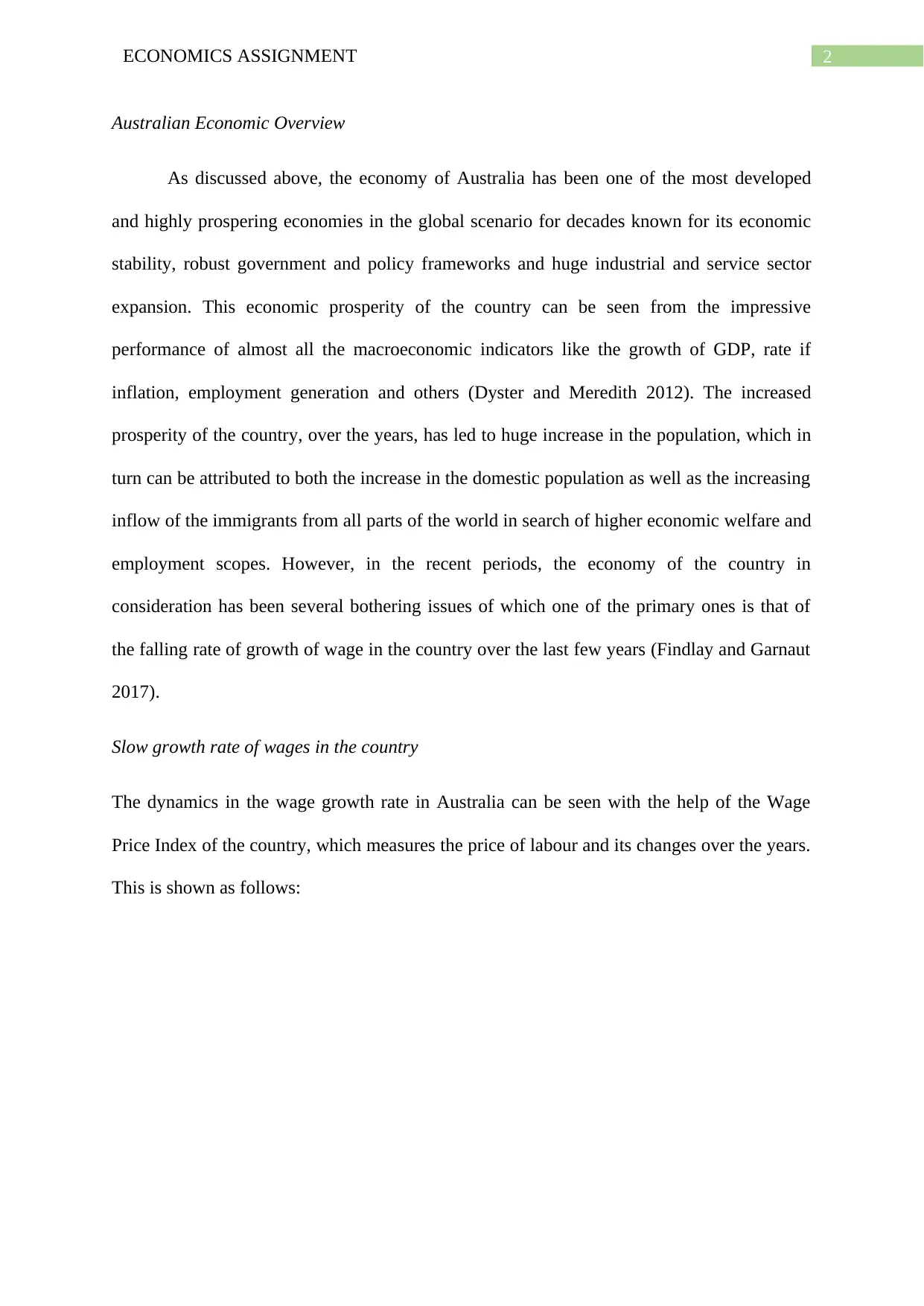
2ECONOMICS ASSIGNMENT
Australian Economic Overview
As discussed above, the economy of Australia has been one of the most developed
and highly prospering economies in the global scenario for decades known for its economic
stability, robust government and policy frameworks and huge industrial and service sector
expansion. This economic prosperity of the country can be seen from the impressive
performance of almost all the macroeconomic indicators like the growth of GDP, rate if
inflation, employment generation and others (Dyster and Meredith 2012). The increased
prosperity of the country, over the years, has led to huge increase in the population, which in
turn can be attributed to both the increase in the domestic population as well as the increasing
inflow of the immigrants from all parts of the world in search of higher economic welfare and
employment scopes. However, in the recent periods, the economy of the country in
consideration has been several bothering issues of which one of the primary ones is that of
the falling rate of growth of wage in the country over the last few years (Findlay and Garnaut
2017).
Slow growth rate of wages in the country
The dynamics in the wage growth rate in Australia can be seen with the help of the Wage
Price Index of the country, which measures the price of labour and its changes over the years.
This is shown as follows:
Australian Economic Overview
As discussed above, the economy of Australia has been one of the most developed
and highly prospering economies in the global scenario for decades known for its economic
stability, robust government and policy frameworks and huge industrial and service sector
expansion. This economic prosperity of the country can be seen from the impressive
performance of almost all the macroeconomic indicators like the growth of GDP, rate if
inflation, employment generation and others (Dyster and Meredith 2012). The increased
prosperity of the country, over the years, has led to huge increase in the population, which in
turn can be attributed to both the increase in the domestic population as well as the increasing
inflow of the immigrants from all parts of the world in search of higher economic welfare and
employment scopes. However, in the recent periods, the economy of the country in
consideration has been several bothering issues of which one of the primary ones is that of
the falling rate of growth of wage in the country over the last few years (Findlay and Garnaut
2017).
Slow growth rate of wages in the country
The dynamics in the wage growth rate in Australia can be seen with the help of the Wage
Price Index of the country, which measures the price of labour and its changes over the years.
This is shown as follows:
⊘ This is a preview!⊘
Do you want full access?
Subscribe today to unlock all pages.

Trusted by 1+ million students worldwide
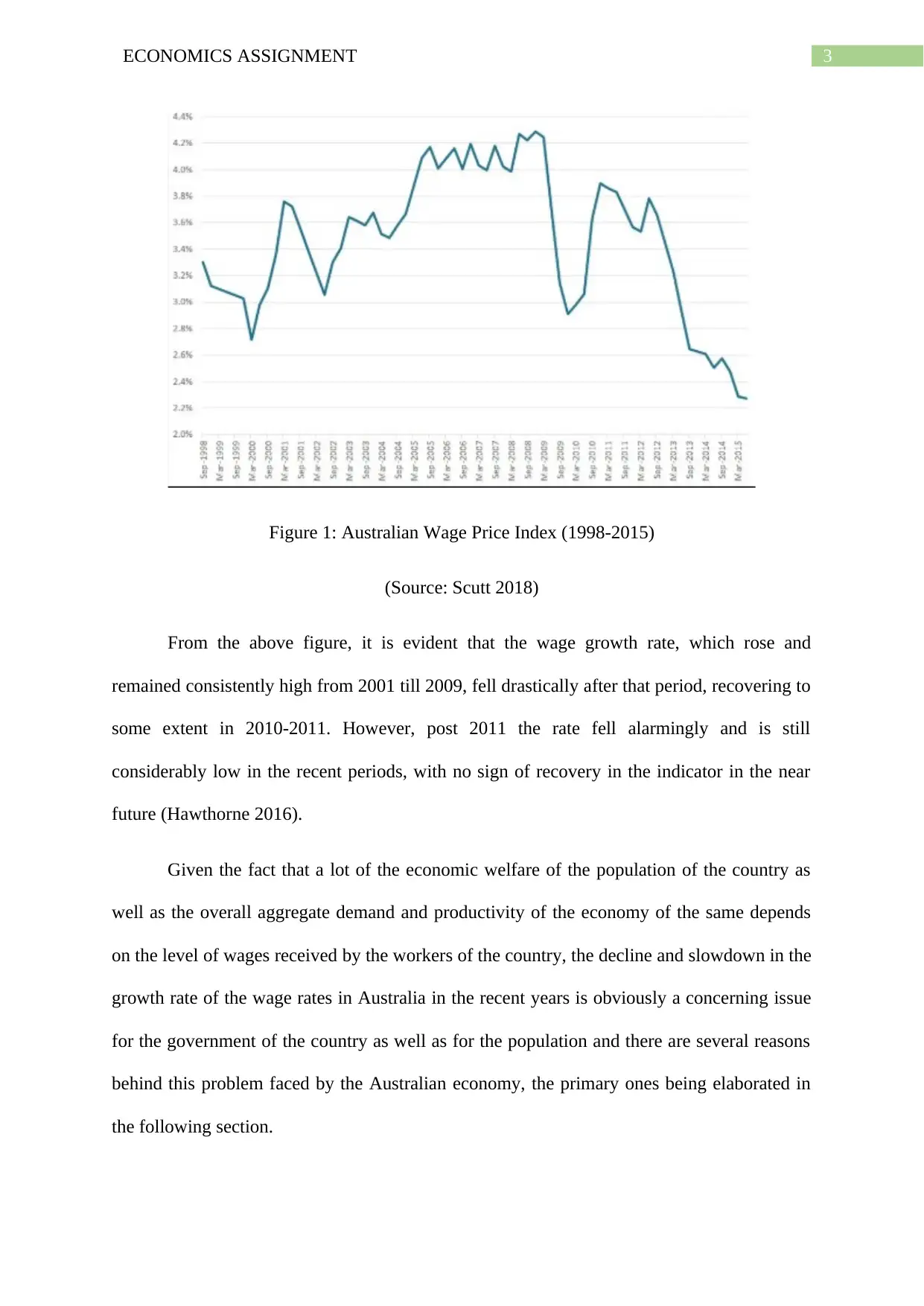
3ECONOMICS ASSIGNMENT
Figure 1: Australian Wage Price Index (1998-2015)
(Source: Scutt 2018)
From the above figure, it is evident that the wage growth rate, which rose and
remained consistently high from 2001 till 2009, fell drastically after that period, recovering to
some extent in 2010-2011. However, post 2011 the rate fell alarmingly and is still
considerably low in the recent periods, with no sign of recovery in the indicator in the near
future (Hawthorne 2016).
Given the fact that a lot of the economic welfare of the population of the country as
well as the overall aggregate demand and productivity of the economy of the same depends
on the level of wages received by the workers of the country, the decline and slowdown in the
growth rate of the wage rates in Australia in the recent years is obviously a concerning issue
for the government of the country as well as for the population and there are several reasons
behind this problem faced by the Australian economy, the primary ones being elaborated in
the following section.
Figure 1: Australian Wage Price Index (1998-2015)
(Source: Scutt 2018)
From the above figure, it is evident that the wage growth rate, which rose and
remained consistently high from 2001 till 2009, fell drastically after that period, recovering to
some extent in 2010-2011. However, post 2011 the rate fell alarmingly and is still
considerably low in the recent periods, with no sign of recovery in the indicator in the near
future (Hawthorne 2016).
Given the fact that a lot of the economic welfare of the population of the country as
well as the overall aggregate demand and productivity of the economy of the same depends
on the level of wages received by the workers of the country, the decline and slowdown in the
growth rate of the wage rates in Australia in the recent years is obviously a concerning issue
for the government of the country as well as for the population and there are several reasons
behind this problem faced by the Australian economy, the primary ones being elaborated in
the following section.
Paraphrase This Document
Need a fresh take? Get an instant paraphrase of this document with our AI Paraphraser
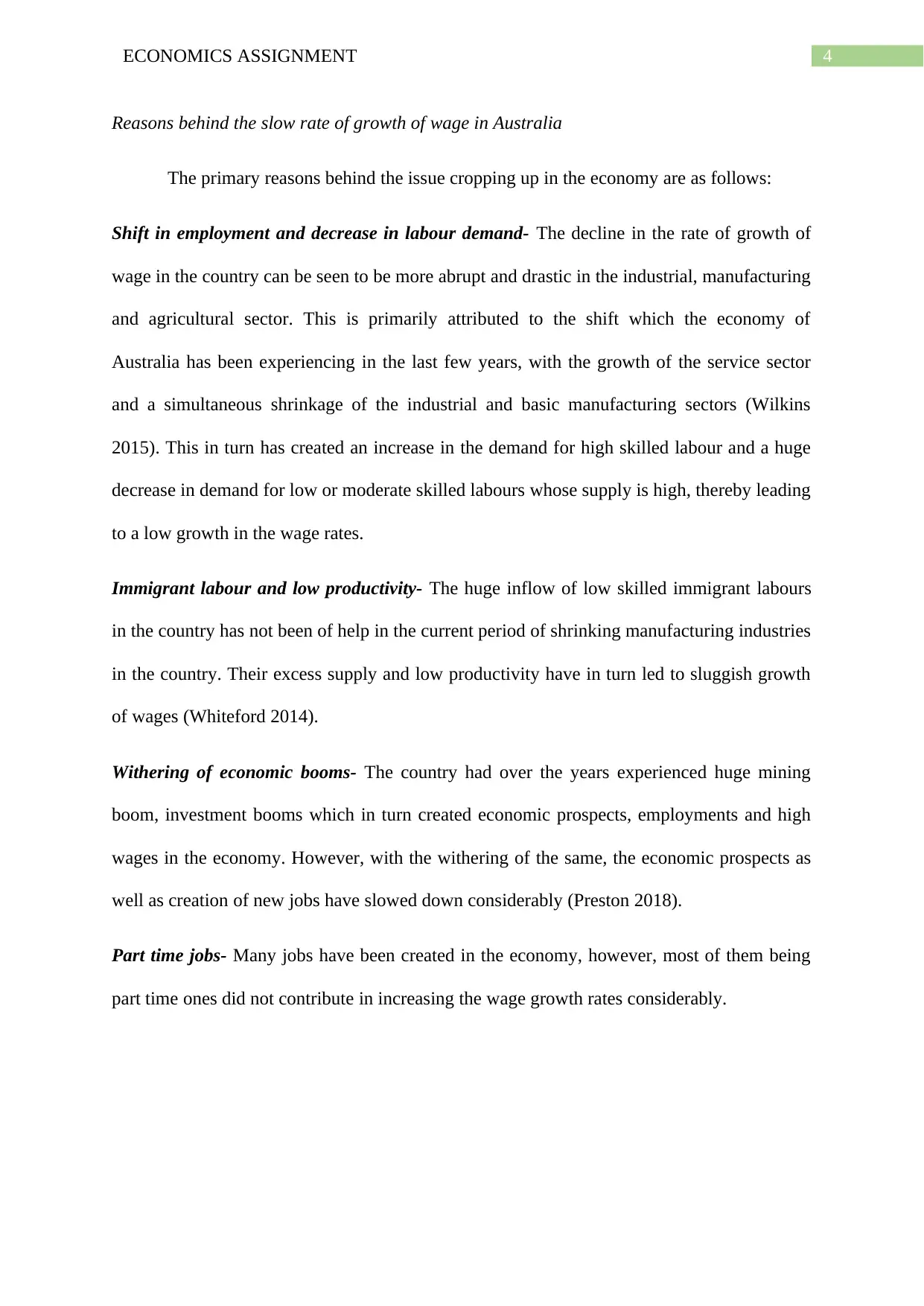
4ECONOMICS ASSIGNMENT
Reasons behind the slow rate of growth of wage in Australia
The primary reasons behind the issue cropping up in the economy are as follows:
Shift in employment and decrease in labour demand- The decline in the rate of growth of
wage in the country can be seen to be more abrupt and drastic in the industrial, manufacturing
and agricultural sector. This is primarily attributed to the shift which the economy of
Australia has been experiencing in the last few years, with the growth of the service sector
and a simultaneous shrinkage of the industrial and basic manufacturing sectors (Wilkins
2015). This in turn has created an increase in the demand for high skilled labour and a huge
decrease in demand for low or moderate skilled labours whose supply is high, thereby leading
to a low growth in the wage rates.
Immigrant labour and low productivity- The huge inflow of low skilled immigrant labours
in the country has not been of help in the current period of shrinking manufacturing industries
in the country. Their excess supply and low productivity have in turn led to sluggish growth
of wages (Whiteford 2014).
Withering of economic booms- The country had over the years experienced huge mining
boom, investment booms which in turn created economic prospects, employments and high
wages in the economy. However, with the withering of the same, the economic prospects as
well as creation of new jobs have slowed down considerably (Preston 2018).
Part time jobs- Many jobs have been created in the economy, however, most of them being
part time ones did not contribute in increasing the wage growth rates considerably.
Reasons behind the slow rate of growth of wage in Australia
The primary reasons behind the issue cropping up in the economy are as follows:
Shift in employment and decrease in labour demand- The decline in the rate of growth of
wage in the country can be seen to be more abrupt and drastic in the industrial, manufacturing
and agricultural sector. This is primarily attributed to the shift which the economy of
Australia has been experiencing in the last few years, with the growth of the service sector
and a simultaneous shrinkage of the industrial and basic manufacturing sectors (Wilkins
2015). This in turn has created an increase in the demand for high skilled labour and a huge
decrease in demand for low or moderate skilled labours whose supply is high, thereby leading
to a low growth in the wage rates.
Immigrant labour and low productivity- The huge inflow of low skilled immigrant labours
in the country has not been of help in the current period of shrinking manufacturing industries
in the country. Their excess supply and low productivity have in turn led to sluggish growth
of wages (Whiteford 2014).
Withering of economic booms- The country had over the years experienced huge mining
boom, investment booms which in turn created economic prospects, employments and high
wages in the economy. However, with the withering of the same, the economic prospects as
well as creation of new jobs have slowed down considerably (Preston 2018).
Part time jobs- Many jobs have been created in the economy, however, most of them being
part time ones did not contribute in increasing the wage growth rates considerably.
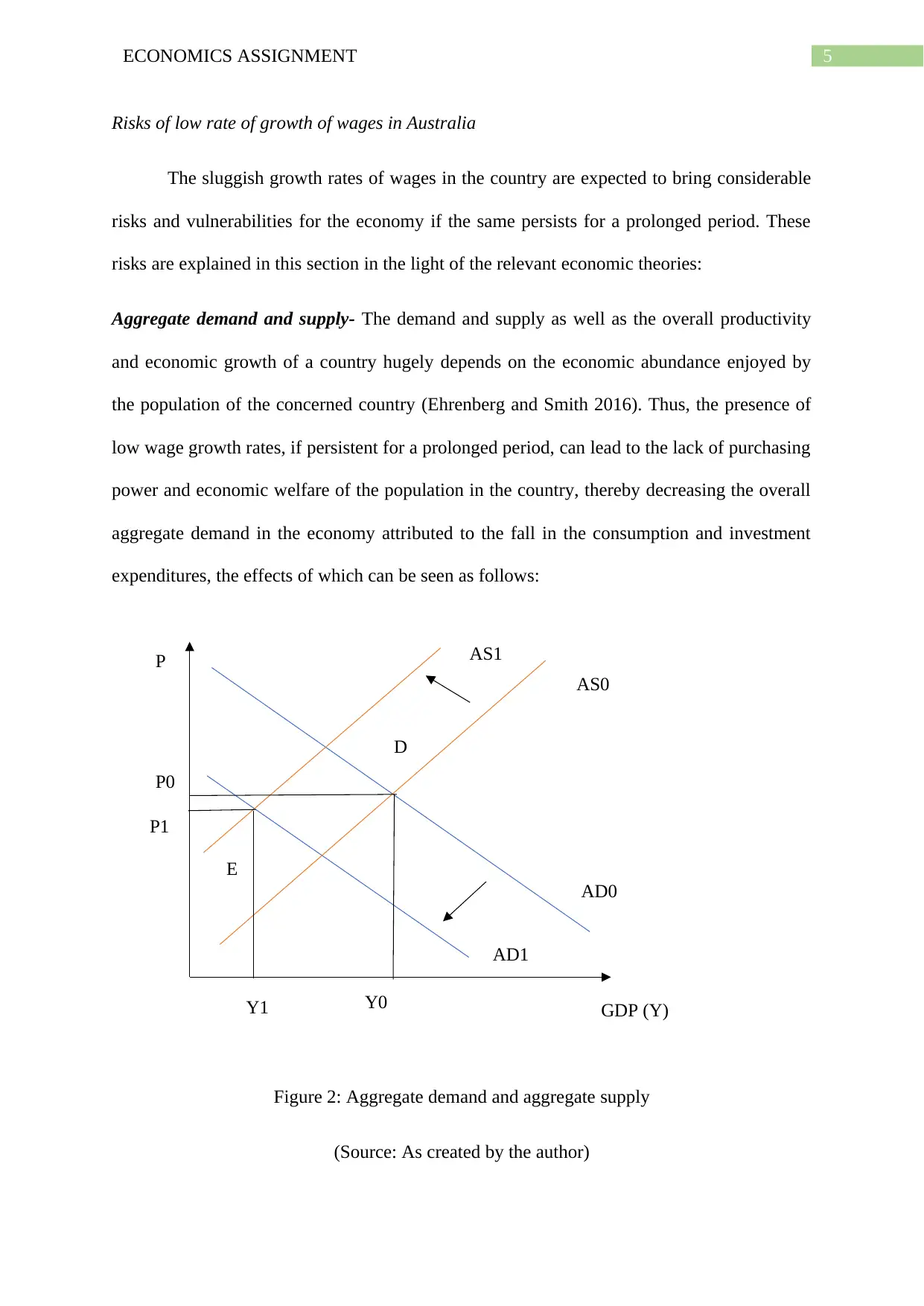
5ECONOMICS ASSIGNMENT
P
P0
P1
Y1 Y0 GDP (Y)
AS1
AS0
AD1
AD0
E
D
Risks of low rate of growth of wages in Australia
The sluggish growth rates of wages in the country are expected to bring considerable
risks and vulnerabilities for the economy if the same persists for a prolonged period. These
risks are explained in this section in the light of the relevant economic theories:
Aggregate demand and supply- The demand and supply as well as the overall productivity
and economic growth of a country hugely depends on the economic abundance enjoyed by
the population of the concerned country (Ehrenberg and Smith 2016). Thus, the presence of
low wage growth rates, if persistent for a prolonged period, can lead to the lack of purchasing
power and economic welfare of the population in the country, thereby decreasing the overall
aggregate demand in the economy attributed to the fall in the consumption and investment
expenditures, the effects of which can be seen as follows:
Figure 2: Aggregate demand and aggregate supply
(Source: As created by the author)
P
P0
P1
Y1 Y0 GDP (Y)
AS1
AS0
AD1
AD0
E
D
Risks of low rate of growth of wages in Australia
The sluggish growth rates of wages in the country are expected to bring considerable
risks and vulnerabilities for the economy if the same persists for a prolonged period. These
risks are explained in this section in the light of the relevant economic theories:
Aggregate demand and supply- The demand and supply as well as the overall productivity
and economic growth of a country hugely depends on the economic abundance enjoyed by
the population of the concerned country (Ehrenberg and Smith 2016). Thus, the presence of
low wage growth rates, if persistent for a prolonged period, can lead to the lack of purchasing
power and economic welfare of the population in the country, thereby decreasing the overall
aggregate demand in the economy attributed to the fall in the consumption and investment
expenditures, the effects of which can be seen as follows:
Figure 2: Aggregate demand and aggregate supply
(Source: As created by the author)
⊘ This is a preview!⊘
Do you want full access?
Subscribe today to unlock all pages.

Trusted by 1+ million students worldwide
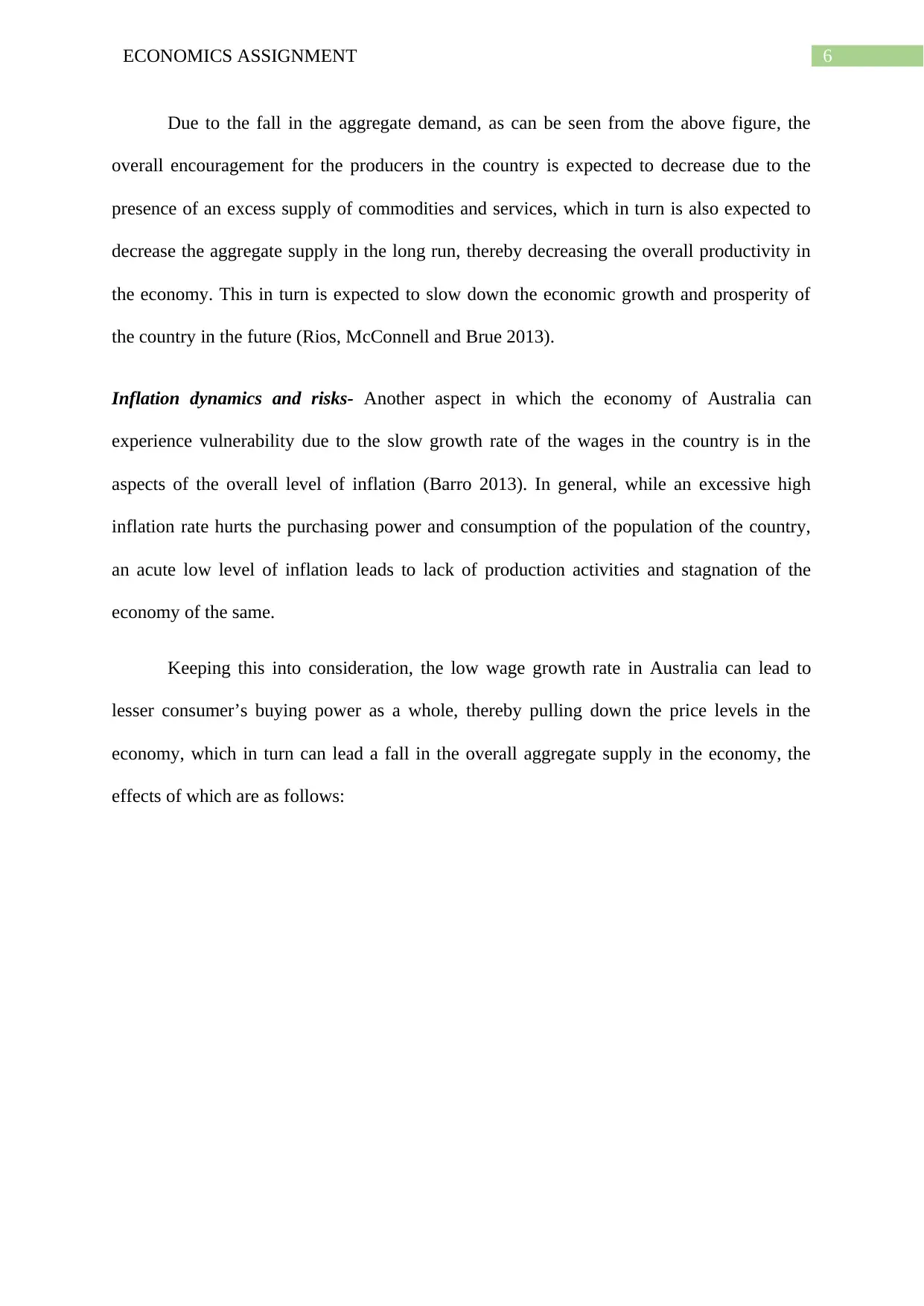
6ECONOMICS ASSIGNMENT
Due to the fall in the aggregate demand, as can be seen from the above figure, the
overall encouragement for the producers in the country is expected to decrease due to the
presence of an excess supply of commodities and services, which in turn is also expected to
decrease the aggregate supply in the long run, thereby decreasing the overall productivity in
the economy. This in turn is expected to slow down the economic growth and prosperity of
the country in the future (Rios, McConnell and Brue 2013).
Inflation dynamics and risks- Another aspect in which the economy of Australia can
experience vulnerability due to the slow growth rate of the wages in the country is in the
aspects of the overall level of inflation (Barro 2013). In general, while an excessive high
inflation rate hurts the purchasing power and consumption of the population of the country,
an acute low level of inflation leads to lack of production activities and stagnation of the
economy of the same.
Keeping this into consideration, the low wage growth rate in Australia can lead to
lesser consumer’s buying power as a whole, thereby pulling down the price levels in the
economy, which in turn can lead a fall in the overall aggregate supply in the economy, the
effects of which are as follows:
Due to the fall in the aggregate demand, as can be seen from the above figure, the
overall encouragement for the producers in the country is expected to decrease due to the
presence of an excess supply of commodities and services, which in turn is also expected to
decrease the aggregate supply in the long run, thereby decreasing the overall productivity in
the economy. This in turn is expected to slow down the economic growth and prosperity of
the country in the future (Rios, McConnell and Brue 2013).
Inflation dynamics and risks- Another aspect in which the economy of Australia can
experience vulnerability due to the slow growth rate of the wages in the country is in the
aspects of the overall level of inflation (Barro 2013). In general, while an excessive high
inflation rate hurts the purchasing power and consumption of the population of the country,
an acute low level of inflation leads to lack of production activities and stagnation of the
economy of the same.
Keeping this into consideration, the low wage growth rate in Australia can lead to
lesser consumer’s buying power as a whole, thereby pulling down the price levels in the
economy, which in turn can lead a fall in the overall aggregate supply in the economy, the
effects of which are as follows:
Paraphrase This Document
Need a fresh take? Get an instant paraphrase of this document with our AI Paraphraser
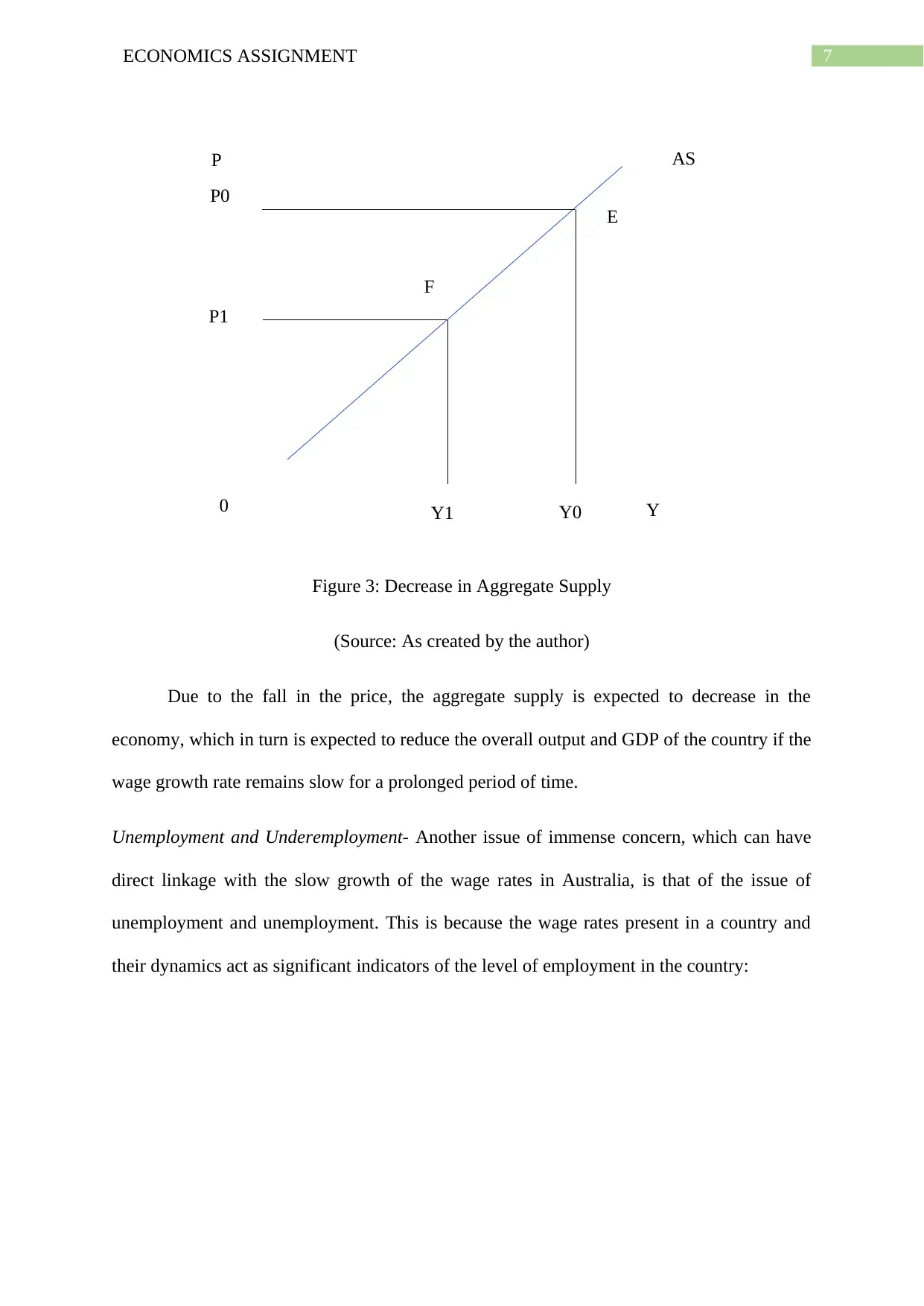
7ECONOMICS ASSIGNMENT
P
P0
P1
0 Y1 Y0 Y
F
E
AS
Figure 3: Decrease in Aggregate Supply
(Source: As created by the author)
Due to the fall in the price, the aggregate supply is expected to decrease in the
economy, which in turn is expected to reduce the overall output and GDP of the country if the
wage growth rate remains slow for a prolonged period of time.
Unemployment and Underemployment- Another issue of immense concern, which can have
direct linkage with the slow growth of the wage rates in Australia, is that of the issue of
unemployment and unemployment. This is because the wage rates present in a country and
their dynamics act as significant indicators of the level of employment in the country:
P
P0
P1
0 Y1 Y0 Y
F
E
AS
Figure 3: Decrease in Aggregate Supply
(Source: As created by the author)
Due to the fall in the price, the aggregate supply is expected to decrease in the
economy, which in turn is expected to reduce the overall output and GDP of the country if the
wage growth rate remains slow for a prolonged period of time.
Unemployment and Underemployment- Another issue of immense concern, which can have
direct linkage with the slow growth of the wage rates in Australia, is that of the issue of
unemployment and unemployment. This is because the wage rates present in a country and
their dynamics act as significant indicators of the level of employment in the country:
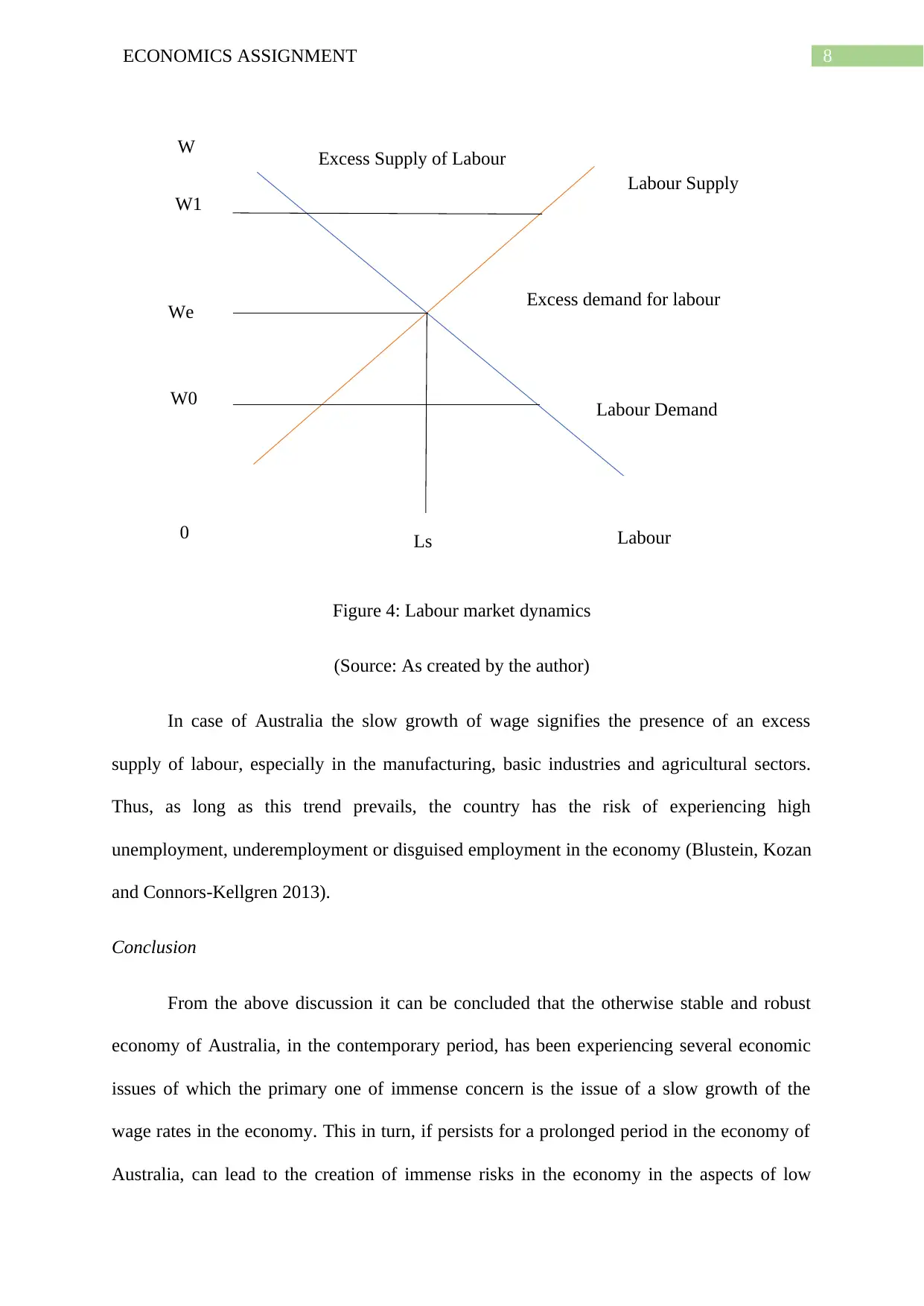
8ECONOMICS ASSIGNMENT
W
We
W1
W0
0 Ls Labour
Labour Supply
Labour Demand
Excess Supply of Labour
Excess demand for labour
Figure 4: Labour market dynamics
(Source: As created by the author)
In case of Australia the slow growth of wage signifies the presence of an excess
supply of labour, especially in the manufacturing, basic industries and agricultural sectors.
Thus, as long as this trend prevails, the country has the risk of experiencing high
unemployment, underemployment or disguised employment in the economy (Blustein, Kozan
and Connors-Kellgren 2013).
Conclusion
From the above discussion it can be concluded that the otherwise stable and robust
economy of Australia, in the contemporary period, has been experiencing several economic
issues of which the primary one of immense concern is the issue of a slow growth of the
wage rates in the economy. This in turn, if persists for a prolonged period in the economy of
Australia, can lead to the creation of immense risks in the economy in the aspects of low
W
We
W1
W0
0 Ls Labour
Labour Supply
Labour Demand
Excess Supply of Labour
Excess demand for labour
Figure 4: Labour market dynamics
(Source: As created by the author)
In case of Australia the slow growth of wage signifies the presence of an excess
supply of labour, especially in the manufacturing, basic industries and agricultural sectors.
Thus, as long as this trend prevails, the country has the risk of experiencing high
unemployment, underemployment or disguised employment in the economy (Blustein, Kozan
and Connors-Kellgren 2013).
Conclusion
From the above discussion it can be concluded that the otherwise stable and robust
economy of Australia, in the contemporary period, has been experiencing several economic
issues of which the primary one of immense concern is the issue of a slow growth of the
wage rates in the economy. This in turn, if persists for a prolonged period in the economy of
Australia, can lead to the creation of immense risks in the economy in the aspects of low
⊘ This is a preview!⊘
Do you want full access?
Subscribe today to unlock all pages.

Trusted by 1+ million students worldwide
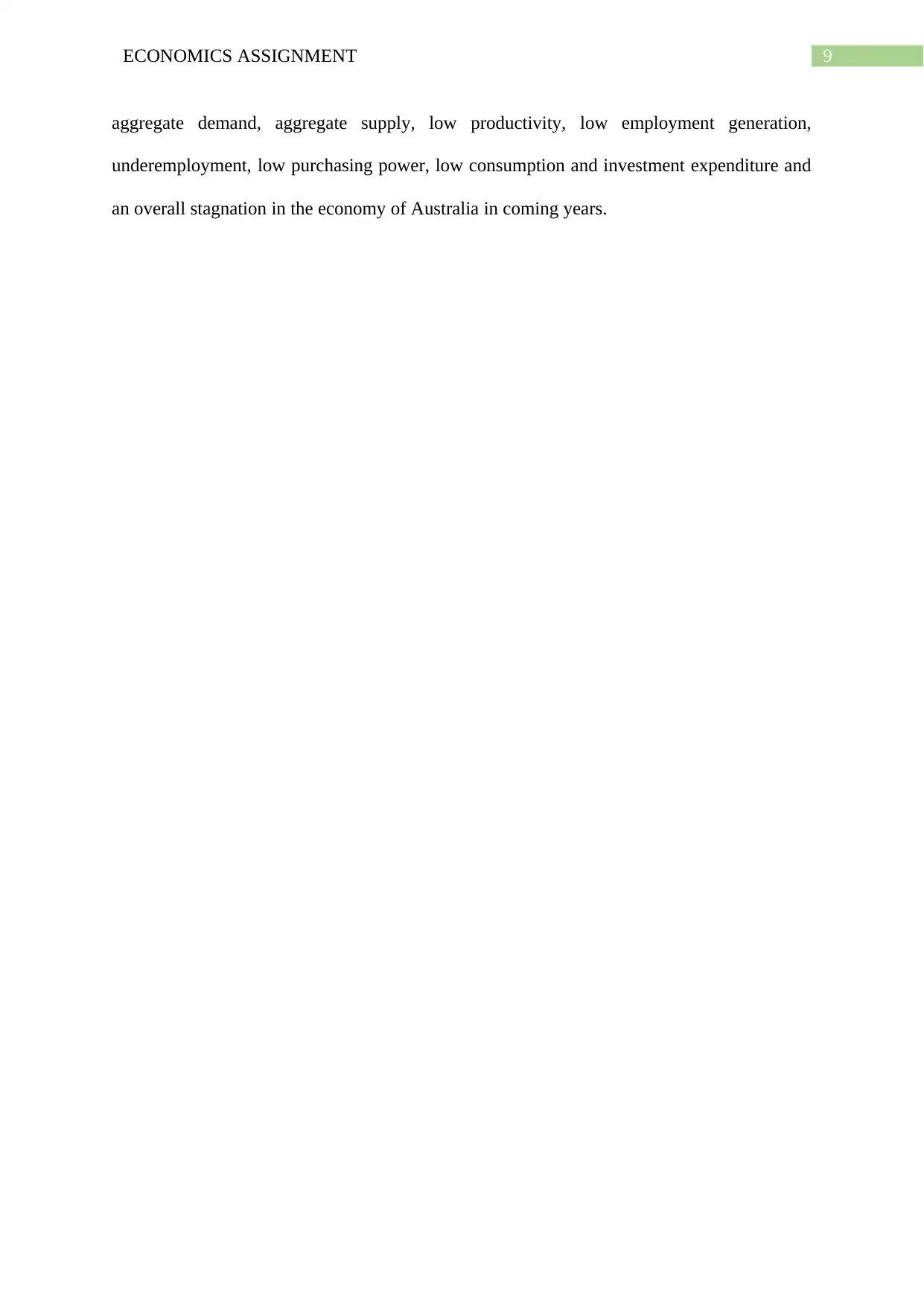
9ECONOMICS ASSIGNMENT
aggregate demand, aggregate supply, low productivity, low employment generation,
underemployment, low purchasing power, low consumption and investment expenditure and
an overall stagnation in the economy of Australia in coming years.
aggregate demand, aggregate supply, low productivity, low employment generation,
underemployment, low purchasing power, low consumption and investment expenditure and
an overall stagnation in the economy of Australia in coming years.
Paraphrase This Document
Need a fresh take? Get an instant paraphrase of this document with our AI Paraphraser
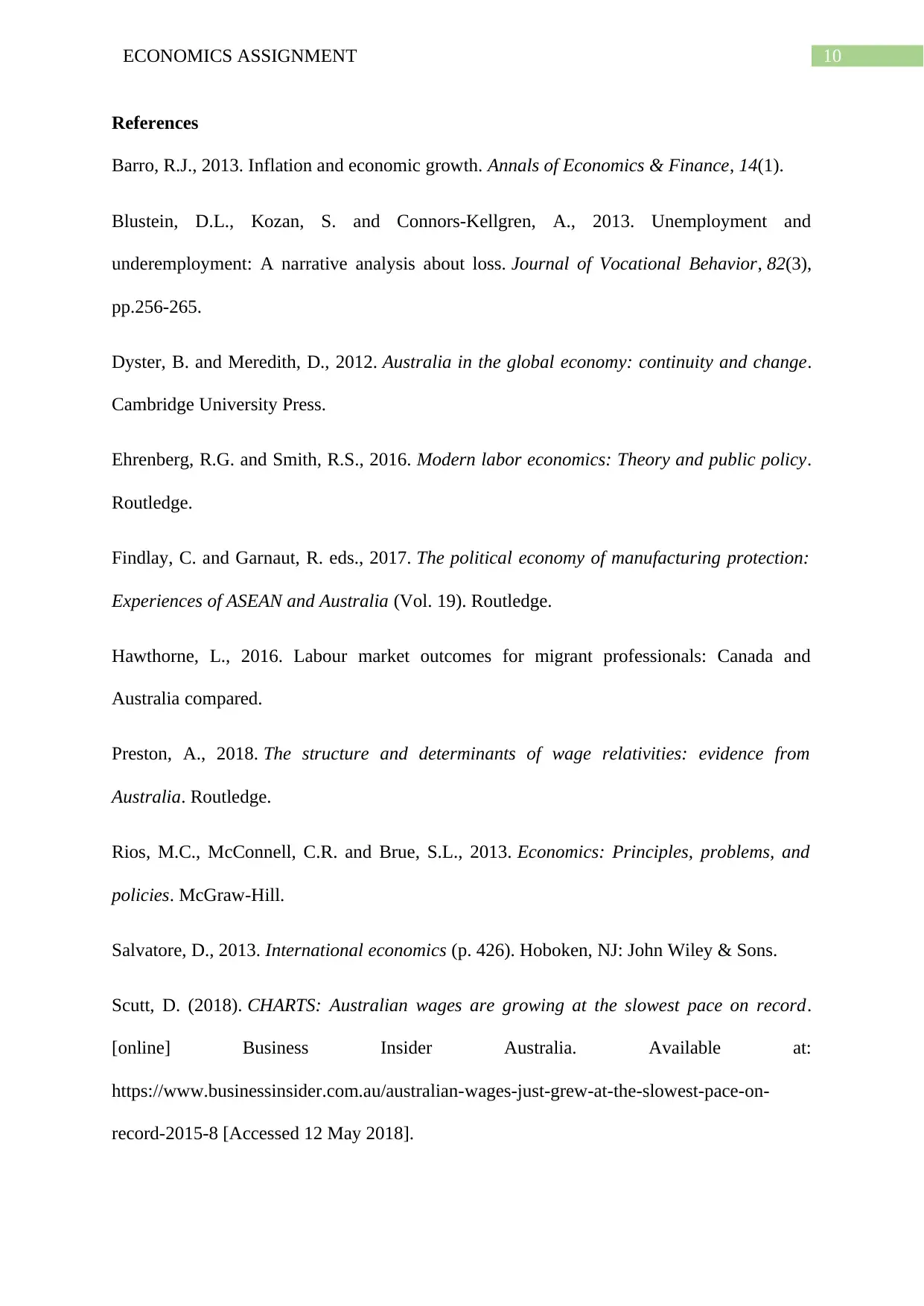
10ECONOMICS ASSIGNMENT
References
Barro, R.J., 2013. Inflation and economic growth. Annals of Economics & Finance, 14(1).
Blustein, D.L., Kozan, S. and Connors-Kellgren, A., 2013. Unemployment and
underemployment: A narrative analysis about loss. Journal of Vocational Behavior, 82(3),
pp.256-265.
Dyster, B. and Meredith, D., 2012. Australia in the global economy: continuity and change.
Cambridge University Press.
Ehrenberg, R.G. and Smith, R.S., 2016. Modern labor economics: Theory and public policy.
Routledge.
Findlay, C. and Garnaut, R. eds., 2017. The political economy of manufacturing protection:
Experiences of ASEAN and Australia (Vol. 19). Routledge.
Hawthorne, L., 2016. Labour market outcomes for migrant professionals: Canada and
Australia compared.
Preston, A., 2018. The structure and determinants of wage relativities: evidence from
Australia. Routledge.
Rios, M.C., McConnell, C.R. and Brue, S.L., 2013. Economics: Principles, problems, and
policies. McGraw-Hill.
Salvatore, D., 2013. International economics (p. 426). Hoboken, NJ: John Wiley & Sons.
Scutt, D. (2018). CHARTS: Australian wages are growing at the slowest pace on record.
[online] Business Insider Australia. Available at:
https://www.businessinsider.com.au/australian-wages-just-grew-at-the-slowest-pace-on-
record-2015-8 [Accessed 12 May 2018].
References
Barro, R.J., 2013. Inflation and economic growth. Annals of Economics & Finance, 14(1).
Blustein, D.L., Kozan, S. and Connors-Kellgren, A., 2013. Unemployment and
underemployment: A narrative analysis about loss. Journal of Vocational Behavior, 82(3),
pp.256-265.
Dyster, B. and Meredith, D., 2012. Australia in the global economy: continuity and change.
Cambridge University Press.
Ehrenberg, R.G. and Smith, R.S., 2016. Modern labor economics: Theory and public policy.
Routledge.
Findlay, C. and Garnaut, R. eds., 2017. The political economy of manufacturing protection:
Experiences of ASEAN and Australia (Vol. 19). Routledge.
Hawthorne, L., 2016. Labour market outcomes for migrant professionals: Canada and
Australia compared.
Preston, A., 2018. The structure and determinants of wage relativities: evidence from
Australia. Routledge.
Rios, M.C., McConnell, C.R. and Brue, S.L., 2013. Economics: Principles, problems, and
policies. McGraw-Hill.
Salvatore, D., 2013. International economics (p. 426). Hoboken, NJ: John Wiley & Sons.
Scutt, D. (2018). CHARTS: Australian wages are growing at the slowest pace on record.
[online] Business Insider Australia. Available at:
https://www.businessinsider.com.au/australian-wages-just-grew-at-the-slowest-pace-on-
record-2015-8 [Accessed 12 May 2018].
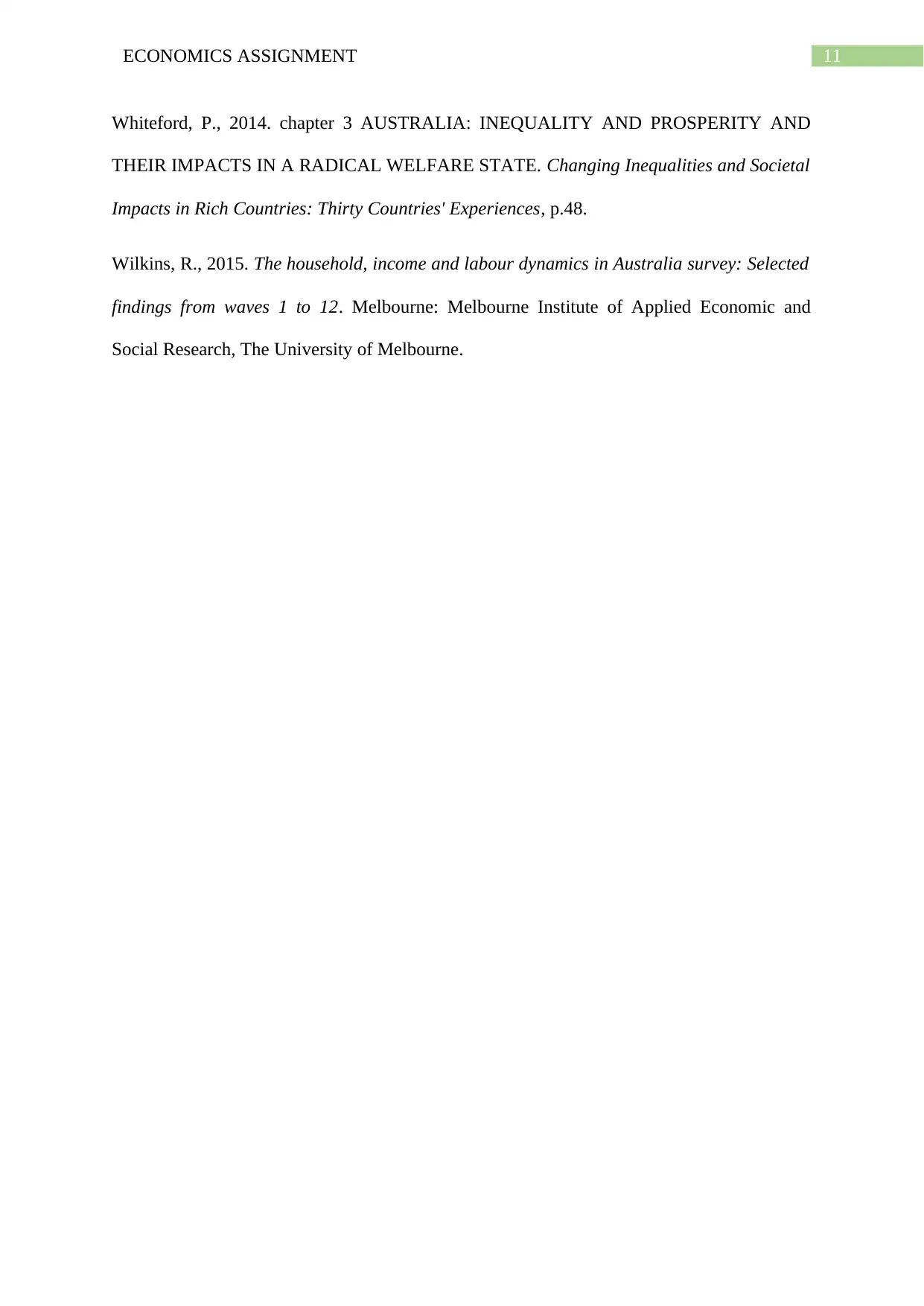
11ECONOMICS ASSIGNMENT
Whiteford, P., 2014. chapter 3 AUSTRALIA: INEQUALITY AND PROSPERITY AND
THEIR IMPACTS IN A RADICAL WELFARE STATE. Changing Inequalities and Societal
Impacts in Rich Countries: Thirty Countries' Experiences, p.48.
Wilkins, R., 2015. The household, income and labour dynamics in Australia survey: Selected
findings from waves 1 to 12. Melbourne: Melbourne Institute of Applied Economic and
Social Research, The University of Melbourne.
Whiteford, P., 2014. chapter 3 AUSTRALIA: INEQUALITY AND PROSPERITY AND
THEIR IMPACTS IN A RADICAL WELFARE STATE. Changing Inequalities and Societal
Impacts in Rich Countries: Thirty Countries' Experiences, p.48.
Wilkins, R., 2015. The household, income and labour dynamics in Australia survey: Selected
findings from waves 1 to 12. Melbourne: Melbourne Institute of Applied Economic and
Social Research, The University of Melbourne.
⊘ This is a preview!⊘
Do you want full access?
Subscribe today to unlock all pages.

Trusted by 1+ million students worldwide
1 out of 12
Related Documents
Your All-in-One AI-Powered Toolkit for Academic Success.
+13062052269
info@desklib.com
Available 24*7 on WhatsApp / Email
![[object Object]](/_next/static/media/star-bottom.7253800d.svg)
Unlock your academic potential
Copyright © 2020–2025 A2Z Services. All Rights Reserved. Developed and managed by ZUCOL.




